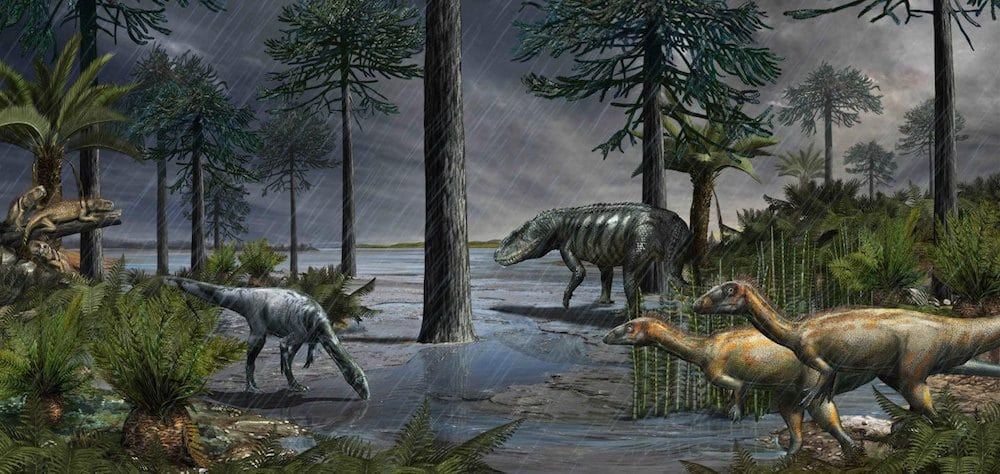
The origins of dinosaurs lie in a massive meteorite strike which gave them a chance of survival, according to a new study.
It is commonly understood that the dinosaurs disappeared with a bang – wiped out by a great meteorite impact on the Earth 66 million years ago.
But researchers now think a meteorite strike around 245 million years ago near the end of a massextinction allowed for a boom in dinosaur numbers.
In the paper, published in journal Nature Communications, scientists from multiple Italian science institutions and the University of Bristol discovered that the blast allowed dinosaurs to diversify and become the dominant species.
Researchers collaborated on the paper from the Museum of Science (MUSE), Trento, Italy, Universities of Ferrara and Padova, Italy and the University of Bristol.
The experts detailed how dinosaurs originated at the beginning of the Triassic Period, 245 million years ago, but their presence on Earth was very rare at that time.
They revealed how a massive meteorite strike 13 million years after this time allowed dinosaurs to diversify – allowing their population to boom globally.
The team showed that dinosaur populations grew to ‘take over’ by using detailed footprint evidence from rock sequences in the Dolomites, northern Italy.
By taking samples of rock successions in the mountain range, the researchers found that before the blast, there was little evidence of skeletons or footprints.
They then compared samples in Argentina and Brazil, which indicated that the blast affected all of these areas at the same time.
Across these areas, there was a marked growth in dinosaur skeletons after the meteorite strike took place.
The strike coincided with a time known as the Carnian Pluvial Episode, marked by extreme climate change.
It appears that the blast came at the end of this event, which was suspected to have caused mass upheavals among life on Earth.
Then, in 2015, dating of rock sections and measurement of oxygen and carbon values showed what had happened in the episode.
There were massive eruptions in western Canada, represented today by the great Wrangellia basalts – which drove bursts of global warming, acid rain, and death on land and in the oceans.
Experts revealed how the massive meteor strike was instrumental in finishing a mass extermination of life, which allowed surviving dinosaurs to spread globally.
Lead author Dr Massimo Bernardi, Curator at MUSE and Research associate at Bristol’s School of Earth Sciences, said: “We were excited to see that the footprints and skeletons told the same story.
“We had been studying the footprints in the Dolomites for some time, and it’s amazing how clear-cut the change from ‘no dinosaurs’ to ‘all dinosaurs’ was.”
Co-author Piero Gianolla, from the University of Ferrara, added: “We had detected evidence for the climate change in the Dolomites.
“There were four pulses of warming and climate perturbation, all within a million years or so – this must have led to repeated extinctions.”
Professor Mike Benton, also a co-author, from the University of Bristol, said: “The discovery of the existence of a link between the first diversification of dinosaurs and a global mass extinction is important.
“The extinction didn’t just clear the way for the age of the dinosaurs, but also for the origins of many modern groups, including lizards, crocodiles, turtles, and mammals – key land animals today.”
https://www.thelondoneconomic.com/news/environment/plant-munched-dinosaurs-found-growing-wild/07/08/
https://www.thelondoneconomic.com/news/giant-dinosaurs-bigger-than-busses-once-roamed-the-isle-of-skye/03/04/